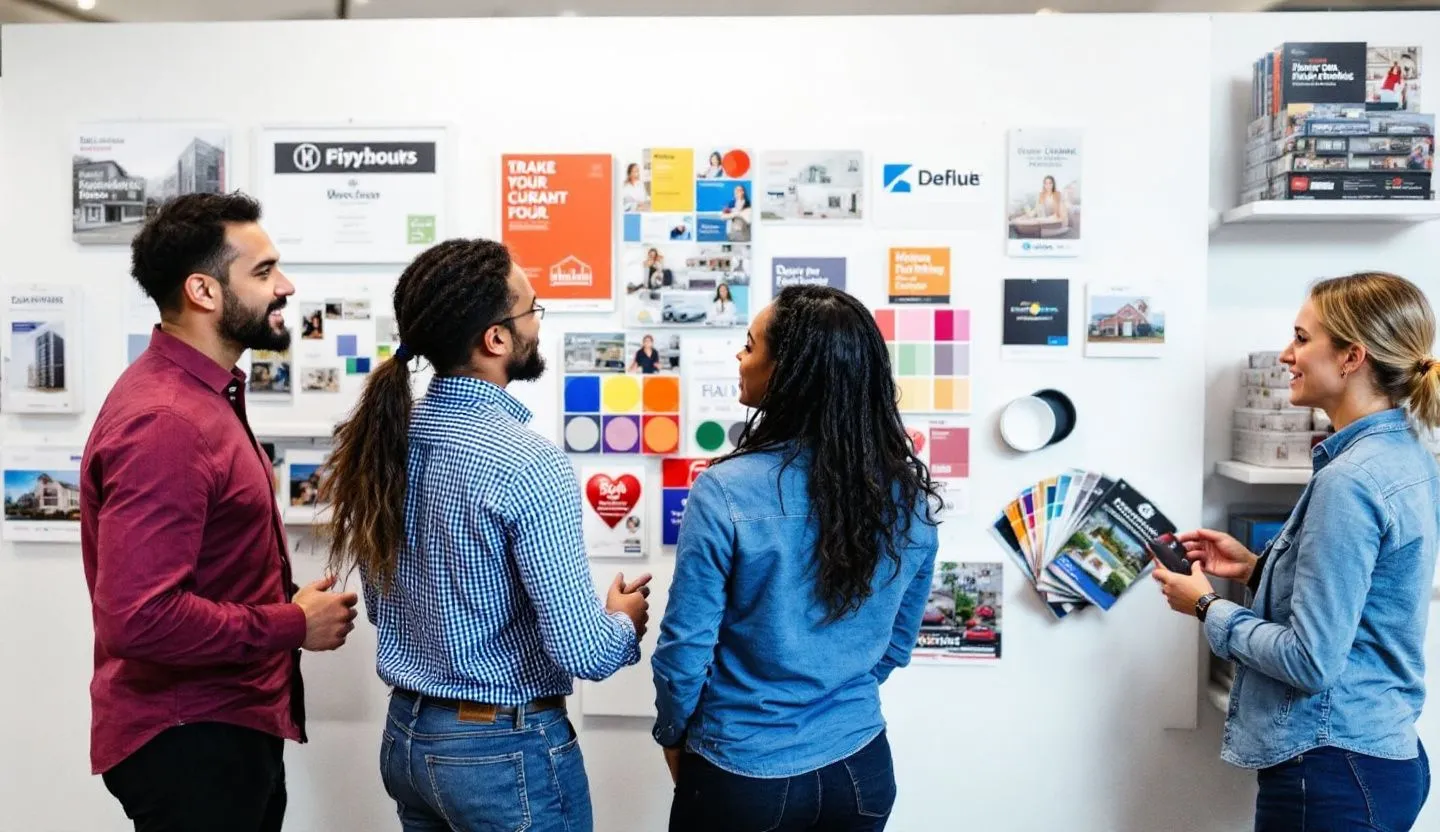I don’t need to tell you that house painting franchise marketing has never been for the faint of heart. We live at the intersection of brand consistency, compliance, and the very real demand for speed-to-market. Every day, I feel that tug-of-war: the desire to unleash local teams’ creativity and hustle,without unraveling the carefully woven threads of our brand. And let’s be honest, the stakes are higher than ever for 2025.
We’re not just painting houses,we’re painting trust, reputation, and equity onto every wall in every market we serve. Whether you’re a CMO balancing a national campaign with hyperlocal needs, a Marketing Ops leader wrangling digital assets, or a compliance officer haunted by rogue messaging, you know the pain. It’s the late-night Slack from a franchisee who needs an Instagram Story now, or the quiet dread that the new campaign’s color palette might not look right under a Texas sun.
But as we move into 2025, the dynamics have shifted. The expectations for house painting franchise marketing are higher, but so are the tools and strategies at our disposal. We’re not just catching up,we’re poised to leap ahead, if we make the right moves.
Let’s dig into what’s really changing, why it matters, and how we can win,together.
The real pain of house painting franchise marketing in 2025
There’s a specific kind of stress that comes with managing marketing at scale in the house painting franchise world. I feel it in every email chain about asset approval, every frantic text about a missing logo, every spreadsheet tracking a hundred local campaigns. It’s the pressure to be everywhere,consistent, compliant, and cutting-edge,without losing sight of the people who actually do the painting.
- Brand consistency versus local relevance: We all know the brand police jokes, but the struggle is real. Franchisees want to stand out in their neighborhoods, but every tweak to a color swatch or tagline chips away at the unified presence we’ve worked so hard to build. Yet, local authenticity matters. How do you let someone in Scottsdale connect with their market without letting things go off the rails in Seattle?
- Speed-to-market versus compliance: The digital world doesn’t wait. When a competitor launches a TikTok trend or a local real estate partner asks for a co-branded flyer, our teams need to act fast. But with speed comes risk,old disclaimers, out-of-date licenses, or, worst of all, messaging that doesn’t pass legal muster in every state.
- Content scale versus quality control: The volume of assets we need,social posts, video walk-throughs, before-and-after galleries, neighborhood-specific landing pages,has exploded. But more isn’t always better. Without tight guardrails and smart workflows, we risk drowning in off-brand, poorly executed content that does more harm than good.
- Siloed tools and disconnected data: Raise your hand if you’ve got one system for asset management, another for local campaign execution, and a third for analytics,none of which talk to each other. (My hand is up, too.) This fragmentation slows us down, breeds duplication, and makes it nearly impossible to optimize across the entire franchise network.
- Rising customer expectations: Homeowners in 2025 expect seamless digital experiences, personalized recommendations, and instant answers. They want to see real results,on their homes, but also in their inboxes and Instagram feeds. If we don’t meet them where they are, with messaging that resonates, someone else will.

Why the marketing landscape is changing for house painting franchises
The old playbook for house painting franchise marketing isn’t just outdated,it’s actively holding us back. The world has shifted, and so have our customers, competitors, and technologies. Here’s what’s driving the change.
- Digital-first home improvement journeys: Today’s homeowners research painting services the way they shop for shoes. They want to see reviews, scroll through Instagram reels of transformations, and book estimates online,often from their phones. If your digital footprint is weak, or your content feels generic, you’re invisible.
- Data-driven personalization: Gone are the days of blanket mailers and generic Facebook ads. Homeowners expect recommendations tailored to their style, their neighborhood, and even their home’s age. If we can’t harness our CRM data and local insights, we’re just another “me-too” brand in their inbox.
- Hybrid work and flexible lifestyles: The pandemic changed how and where people spend their time. More people are working from home, noticing the scuffs on their walls, and investing in upgrades. But they’re also busier and more distracted than ever. Our marketing must cut through the noise with relevance, speed, and value.
- Tighter regulations and compliance scrutiny: From TCPA to ADA and fair housing laws, the legal landscape is more complex than ever. A single misstep in a local ad or SMS campaign can turn into a major headache. Compliance isn’t a checkbox,it’s a daily discipline.
- The rise of local influencers and micro-creators: Homeowners trust their neighbors, not just brands. Local influencers, neighborhood Facebook admins, and even satisfied customers have more sway than ever. The challenge: how do we empower them to tell our story, without losing control?
How to build franchise brand awareness in a crowded market
If you want to grow in 2025, brand awareness is the price of entry. But “awareness” isn’t a vanity metric,it’s about being top-of-mind at the exact moment someone thinks, “Maybe it’s time to repaint.” Here’s how I approach it, with an eye on both scale and nuance.
- Unified brand presence, everywhere: Every touchpoint,from yard signs to Instagram Stories to the van parked on Maple Street,should reinforce who we are and what we stand for. That means clear visual guidelines, a compelling brand voice, and a toolkit that makes it easy for franchisees to get it right. I’ve found that a centralized digital asset management (DAM) system, with locked templates and usage rights, is non-negotiable.
- Local SEO and Google My Business optimization: When someone searches “house painter near me” or “best house painting franchise in [city],” we need to show up,high, often, and with glowing reviews. This takes ongoing effort: updating listings, responding to reviews, and optimizing for new Google features. Franchisees need simple playbooks and support, not just a one-time training.
- Strategic partnerships with real estate pros: Real estate agents, property managers, and home stagers are powerful amplifiers. I’ve seen success with co-branded content,think “Top 5 Color Trends for [City] Homes”,that positions us as the expert and builds goodwill with partners who can send us warm leads.
- Hyperlocal social campaigns: National branding is great, but nothing beats seeing a neighbor’s house transformed. Encourage franchisees to share before-and-after photos, customer testimonials, and neighborhood shout-outs. The key is providing easy-to-use, brand-safe templates and clear guardrails, so creativity doesn’t turn into chaos.
- Community events and sponsorships: Sometimes, old-school tactics still work,especially when they’re done thoughtfully. Sponsor a local Little League team, host a free “Color Consult Day” at the community center, or partner with a charity for a “Paint It Forward” event. These moments build goodwill and keep your brand top-of-mind in ways digital alone can’t.

Driving engagement that leads to real business growth
Brand awareness is just the start. Engagement,real, two-way interaction with prospects and customers,is where growth happens. In 2025, that means meeting people where they are, with content and experiences that feel personal, useful, and trustworthy.
- Personalized content at scale: With the right martech stack, it’s possible to deliver tailored email campaigns, SMS reminders, and digital ads based on a homeowner’s history, preferences, and even seasonal needs. The trick: automate where possible, but always give local teams the ability to add their human touch. For example, I like to offer franchisees a library of “plug-and-play” email templates, but with editable sections for local events or promotions.
- Video walk-throughs and live consultations: Video isn’t optional anymore,it’s the expectation. I encourage teams to film short, authentic walk-throughs (“Here’s how we prep for a two-story repaint in [Neighborhood]”) or offer live Q&A sessions on Facebook and Instagram. These build trust, answer real questions, and showcase expertise in a way static photos never could.
- Interactive tools and calculators: Homeowners love to play with color. Integrate “visualize your home” tools on your website, or offer paint cost calculators that use real local pricing. These not only engage visitors, but also generate qualified leads for follow-up.
- Customer reviews and social proof: Nothing drives engagement like seeing a neighbor rave about your work. Make it easy for happy customers to leave reviews on Google, Yelp, or Facebook, and showcase the best ones on your website and in email campaigns. I’ve found that a simple post-project follow-up (“How did we do?”) can triple review rates,and a quick thank-you note builds loyalty.
- Responding in real time: Engagement is a two-way street. Train local teams to monitor and respond to DMs, comments, and reviews promptly. Equip them with brand-safe responses, but give them the freedom to be human,especially when handling complaints or tough questions.
Fueling franchise growth with scalable, compliant marketing operations
Here’s where the rubber meets the road: can we grow fast, without breaking things? The answer depends on our ability to execute at scale, stay compliant, and support every franchisee,no matter how big or small their market.
- Centralized brand management: A single source of truth for all assets, guidelines, and templates is non-negotiable. But it can’t be a black hole,franchisees need to find, customize, and deploy materials quickly, without bottlenecks. I’ve seen success with platforms that offer role-based access, dynamic templates, and real-time approval workflows. This keeps us compliant, on-brand, and agile.
- Automated compliance checks: With regulations evolving, manual reviews just don’t cut it. Invest in tools that scan digital and print assets for required disclaimers, license numbers, and accessibility standards before they go live. This isn’t about playing “gotcha”,it’s about protecting the brand and the business, at scale.
- Integrated analytics for local and national insight: Siloed reporting is a growth killer. We need dashboards that show not just clicks and likes, but real business outcomes,leads, booked jobs, customer retention,broken down by region, campaign, and channel. That way, we can double down on what works and pivot fast when something’s off.
- Empowering franchisees, not overwhelming them: The best marketing ops programs make life easier for local teams. That means mobile-friendly tools, just-in-time training, and support channels that actually respond. I like to set up a regular cadence of office hours, webinars, and a Slack channel where franchisees can ask questions, share wins, and flag challenges.
- Secure, integrated solutions for IT and compliance: Security is not an afterthought. With more data flowing between HQ and local offices,not to mention third-party partners,we need platforms that are SOC 2 compliant, offer SSO, and integrate seamlessly with our CRM and other enterprise tools. I work closely with IT, legal, and risk to vet every new solution. It’s not always fun, but it pays off in peace of mind.

Real-world examples of marketing strategies in action
Let’s get specific. Here are a few ways I’ve seen house painting franchise marketing strategies deliver real results,without sacrificing brand, compliance, or sanity.
- Localized digital campaigns that boost bookings: One Midwest franchisee used geo-targeted Facebook and Google ads, combined with before-and-after project photos from real local homes. They saw a 40% increase in online inquiries and a 25% bump in booked estimates over the previous quarter. The secret: using HQ-provided templates, but swapping in their own project shots and customer reviews.
- Seamless co-branding with real estate partners: In the Southeast, a franchise built a referral program with top realtors. They co-hosted webinars on “How Paint Sells Homes Faster” and shared downloadable guides for sellers. Not only did this drive direct referrals, but it positioned the franchise as a trusted advisor,resulting in longer-term relationships and higher-value projects.
- Automated review requests and follow-up: One national brand rolled out a post-job SMS campaign that asked customers for feedback, then routed five-star reviews to Google and flagged any issues for follow-up. In six months, their average review score jumped from 4.2 to 4.8, and negative feedback dropped by half,thanks to quick, personal responses to unhappy clients.
- Brand-safe influencer partnerships: A West Coast franchise piloted a “Neighborhood Ambassadors” program, enlisting local micro-influencers to document their painting projects on Instagram. HQ provided guidelines and pre-approved messaging, but let influencers tell their own stories. The result: a 3x increase in local followers, and a waiting list for spring bookings.
Building a culture of marketing agility and brand control
The best house painting franchise marketing teams aren’t just fast,they’re resilient, collaborative, and obsessed with learning. In 2025, that means embracing a mindset of continuous improvement, where every campaign, tool, and workflow is up for optimization.
- Foster open communication between HQ and franchisees: I’ve found that the more we listen to local teams,their challenges, ideas, and wins,the better our national programs become. Regular feedback loops, surveys, and “voice of the franchisee” councils keep us honest and innovative.
- Test, learn, and iterate: Gone are the days of “set it and forget it” campaigns. Use A/B testing for everything from email subject lines to landing page layouts. Share learnings across the network, so a win in Phoenix can become a playbook in Pittsburgh.
- Celebrate local wins, share national learnings: Recognition matters. Spotlight franchisees who crush their goals, launch creative campaigns, or deliver exceptional customer service. At the same time, make it easy to access best practices and resources,whether through an internal knowledge base, webinars, or peer mentoring.
- Invest in ongoing training and upskilling: Marketing changes fast. Offer regular workshops on new tools, compliance updates, and creative trends. Encourage certifications in digital marketing, analytics, or customer experience. The more confident your teams are, the more they’ll own and elevate your brand.

The role of technology in modern house painting franchise marketing
We can’t talk about scaling marketing without talking about technology. The right stack isn’t about chasing shiny objects,it’s about making life easier, safer, and more effective for everyone from the CMO to the local estimator.
- Digital asset management (DAM) and templating: I’m a believer in systems that let us lock down core brand elements, but allow for local customization. With role-based permissions, franchisees can access what they need, when they need it,without risking compliance or version control nightmares.
- Integrated CRM and marketing automation: The dream is a single view of every customer,from first click to final invoice. The reality: too many systems, too little integration. I push hard for platforms that sync CRM, email, SMS, and ad campaigns, so we can track the full journey and optimize for conversion, not just clicks.
- Mobile-first tools for the field: Franchisees aren’t chained to desks. They’re on jobsites, in trucks, at home shows. Mobile-friendly tools for quoting, scheduling, and marketing make it possible to respond in real time and capture opportunities as they arise.
- Analytics and reporting dashboards: Data is only as good as what you do with it. I want dashboards that make it easy to see what’s working,by channel, region, campaign,and where we’re falling short. Bonus points for tools that surface insights and recommendations, not just raw numbers.
- Security, privacy, and compliance built-in: As stewards of customer data, we can’t afford shortcuts. Every tool in our stack needs to meet or exceed industry standards for security, privacy, and regulatory compliance. I work closely with IT and legal to ensure we’re ahead of the curve,not playing catch-up after a breach or audit.
Making the case for investment in marketing innovation
It’s easy to get so caught up in the day-to-day that we forget the bigger picture: marketing isn’t a cost center, it’s a growth engine. But to unlock its full potential, we need to invest,not just in tools, but in people, processes, and partnerships.
- Quantify the ROI of marketing programs: I make it a priority to connect the dots between campaigns and business outcomes,leads generated, jobs booked, lifetime customer value. The more we can demonstrate the tangible impact of marketing, the easier it is to secure buy-in from finance, operations, and the C-suite.
- Pilot, prove, and scale: Not every innovation needs to be a moonshot. I like to start with pilot programs,test a new automation tool in one region, try influencer partnerships in another. Measure the results, refine the approach, then roll out what works across the network.
- Build cross-functional partnerships: The best marketing teams don’t operate in silos. I work closely with IT, legal, operations, and even field staff to ensure our programs are realistic, compliant, and aligned with broader business goals.
- Advocate for continuous learning: The marketing landscape shifts quickly. Encourage your teams to attend industry conferences, pursue certifications, and stay curious about new trends. The more we learn, the better we can anticipate what’s next.
The world of house painting franchise marketing is more complex,and more exciting,than ever as we head into 2025. We’re balancing the timeless demands of brand consistency, speed, and compliance with a new reality: customers who expect seamless digital experiences, personalized outreach, and authentic local connections. The pain is real, but so is the opportunity. By investing in the right mix of technology, training, and agile processes, we can build brands that are both trusted and dynamic, meeting homeowners exactly where they are and turning every interaction into a chance to grow.
For enterprise marketing leaders, the path forward is clear but not easy. We need to champion smarter systems that empower local teams, foster real engagement, and deliver measurable business results,without sacrificing control or security. It’s about more than just painting houses; it’s about painting a futurewhere every franchise, in every market, has the tools and confidence to shine. By working together,across disciplines, departments, and regions,we can transform the challenges of 2025 into our biggest wins yet.







